Your Cart is Empty
Free shipping over 12.99 丨 30-Day Money-Back Guarantee 丨shipping: 2-3Days
Free shipping over 12.99 丨 30-Day Money-Back Guarantee 丨shipping: 2-3Days

Electrical Installation Requirements, IET Wiring Regulations, 18th Edition, BS 7671:2018+A2:2022
The IET Wiring Regulations are the national standard to which all domestic and industrial wiring must conform. It is essential for all those concerned with the design, installation and maintenance of electrical wiring in buildings. The 18th edition is a major update to the title with extensive changes to many areas of BS 7671. The 18th edition has been further updated to include two subsequent amendments, BS 7671:2018+A2:2022. BS 7671:2018+A2:2022 incorporates changes to the First Amendment on electric vehicle charging units, published in 2020, to provide additional guidance on the adoption of evolving technologies within this area.
Other changes in Amendment 2 include protection against thermal effects and fires caused by electrical equipment, protection against voltage interference and electromagnetic interference, and new sections on low-voltage electrical installations for producers and consumers, including energy efficiency measures, interfaces with smart grids, electricity consumption management, renewable electricity management and energy storage.
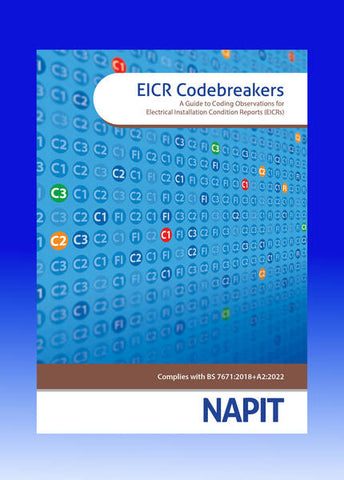
This guide is designed to help contractors carry out regular inspections and tests. It provides information on a range of observations that may be encountered in existing electrical installations.
It provides recommendations for possible coding by BS 7671:2018 for a range of observations. As the industry emphasizes accurate electrical installation condition reporting (EICR), it is important that inspectors code their observations in an understandable and quantifiable manner. To enhance any inspection and testing, this guide also discusses guidance and information, including risk assessment, inspection frequency for inspectors and clients, and safe isolation procedures in domestic and commercial/industrial environments.
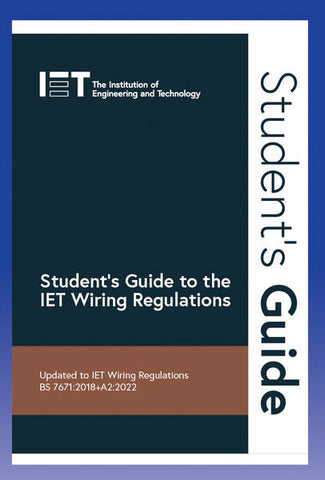
This guide uses diagrams and examples to provide students with guidance to help them navigate the information provided in BS 7671 as they progress through the electrical course.
The IET Wiring Regulations Student Guide is designed for students studying in the electrical industry. The content will enhance the reader's understanding of the IET Wiring Regulations and how to interpret them, as well as integrate them with the qualifications currently on offer.
The simple format, using diagrams and examples, provides students with guidance to help them navigate the information provided in BS 7671 as they progress through their electrical course.
This book provides information on the various acts and regulations that students need to know throughout their studies and careers, including easy-to-understand guidance designed to develop practical skills and understanding of simple circuits.
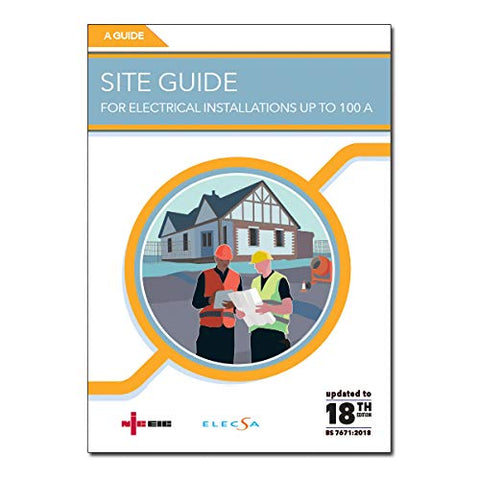
This guide is for contractors carrying out electrical installation work in dwellings (including houses and flats). It provides information and guidance on the design, construction, inspection, testing and certification of electrical installation work in dwellings and is designed to promote good practice and help understand the basic concepts of safety protection. The guide is based on the requirements of BS 7671: 2018 Electrical Installation Requirements and the code numbers quoted are those contained in the standard. This guide is intended to complement other authoritative guidance published by NICEIC, ELECSA and other reputable bodies. Why Contractors Prefer NICEIC and ELECSA Site Guide This site guide has a more detailed way for engineers to actually test the installation drawings for tips and advice. It is more concise and gives a more practical solution to the provision for installing cables and also gives guidance on difficult/unusual situations that engineers may encounter when installing electrical installations. John Radford, Compliance Delivery Manager at Gentoo.
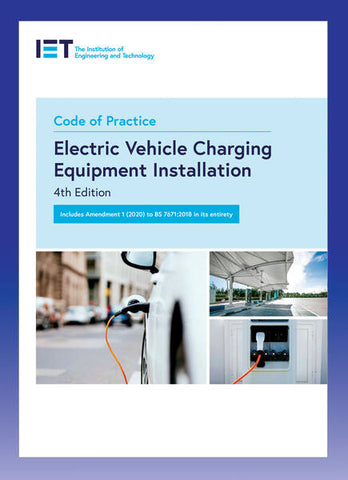
The main changes in the 4th edition include
General requirements - updated to reflect the latest revisions to BS 7671 (specifically within section 722)
Street Installations - updated section to reflect a range of scenarios
Residential Installations - updated section to provide greater clarity on domestic installations
Three-stage installation - more detail in the commercial and industrial sections of the code
Vehicle to Grid - section updated and expanded to provide useful context for this emerging development and to provide detailed information on installation issues
Smart Infrastructure Integration - updated to cover installation considerations as EV charging becomes increasingly complex as it needs to be compatible and integrated with a range of other systems and installations
Wireless charging - as its potential begins to be established and realized, the very well-developed code of practice for extending coverage in this area supported by all key industry stakeholders is essential reading material for anyone involved in the rapid expansion of EV charging points and the maintenance, expansion, modification and periodic verification of electrical installations incorporating EVs.

Guidance Note 3: Inspection & Testing is a basic guide for all those involved in the testing and inspection of electrical installations. It also contains essential guidance for those studying for inspection and testing qualifications and has been fully updated to BS 7671:2018:2022.
BS 7671:2018+A2:2022 incorporates changes to the First Amendment on electric vehicle charging units published in 2020 to provide additional guidance on the adoption of evolving technologies within the sector. Other changes in Amendment 2 include protection against thermal effects and fires caused by electrical equipment, protection against voltage interference and electromagnetic interference, and a new section on low-voltage electrical installations for consumers, including energy efficiency measures, interfaces with smart grids, electricity consumption management, renewable electricity management and energy storage.
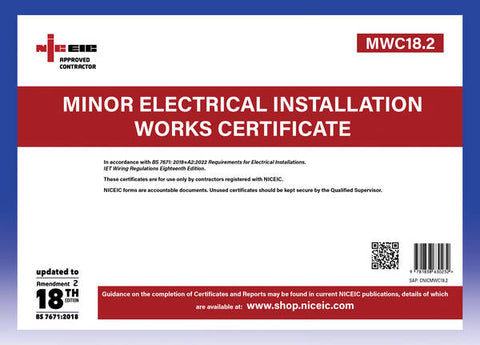
The NICEIC Minor Electrical Installation Works Certificate is for additions or changes to individual circuits only, but does not extend to the provision of new circuits. Examples of where this certificate can be used include adding sockets or lighting points to an existing circuit. This certificate can also be used to replace equipment such as fittings or light fittings, but not to replace switchboards or similar items.
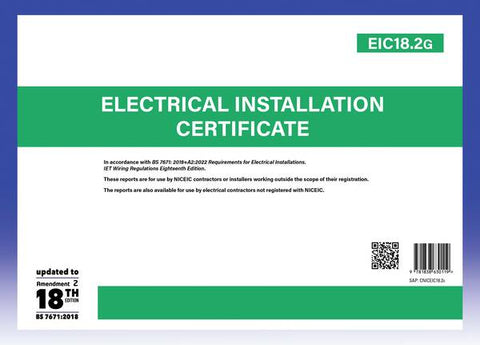
The NICEIC Electrical Installation Certificate will be used for the initial certification of new installations or new work associated with additions or changes to existing installations, including the replacement of switchboards (or consumer units), by BS 7671:2018+A2:2022.
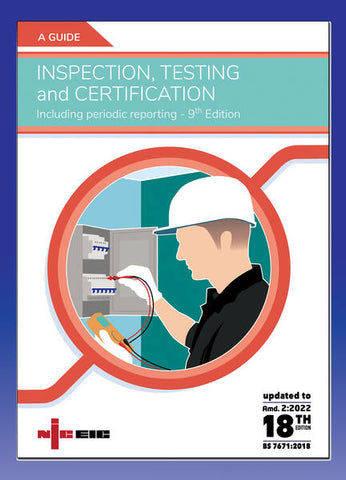
Understanding the requirements of BS 7671: 2018+A2:2022
This book provides practical advice and guidance on the inspection and testing of electrical installations and the completion of NICEIC certificates and reports. The information provided is intended to complement Part 6 of BS 7671:2018+A2:2022 and covers the general requirements relating to the inspection and testing of electrical installations forming part of TN-CS, TN-S and TT electrical systems. It also provides comprehensive guidance for the completion of
NICEIC electrical installation certificates, including minor works certificates.
a report on the condition of the electrical installation, the
Inspection plans and test results
Execution of a range of test methods and verification of results
The revised text is supported by concise illustrations and detailed tables.

The On-Site Guide is an essential guide to BS 7671. It incorporates a large number of changes from BS 7671:2018, making it an essential guide for keeping up to date. It enables competent electricians to handle installations (up to 100 A, three-phase), providing essential information in a convenient, easy-to-use format. This publication has been further updated to include two subsequent revisions to the IET wiring regulations, BS 7671:2018 + A2:2022.
BS 7671:2018+A2:2022 incorporates changes to the first amendment on electric vehicle charging units published in 2020 to provide additional guidance on the adoption of evolving technologies within the sector.
Other changes in Amendment 2 include protection against thermal effects and fires caused by electrical equipment, protection against voltage interference and electromagnetic interference, and new sections on low-voltage electrical installations for producers and consumers, including energy efficiency measures, interfaces with smart grids, electricity consumption management, renewable electricity management and energy storage.
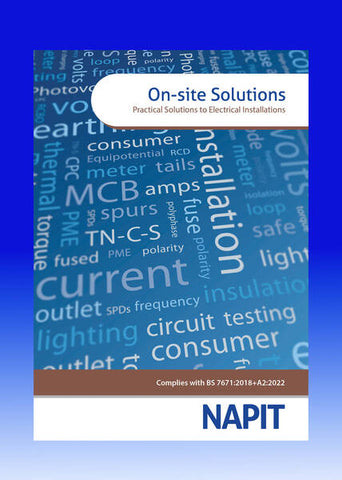
As NAPIT continues to work to improve standards and working practices across the electrical industry, we felt the need to look at the way electrical installations are designed, installed and maintained, taking into account any legislation that may affect them.
Good and appropriate solutions to the everyday problems encountered by electricians in the field are of paramount importance to NAPIT's technical writers. With this in mind, NAPIT has produced a Field Solutions book.
This field solutions book is designed to help electricians understand and overcome the everyday problems they encounter. It is an important toolbox document that should be readily available.
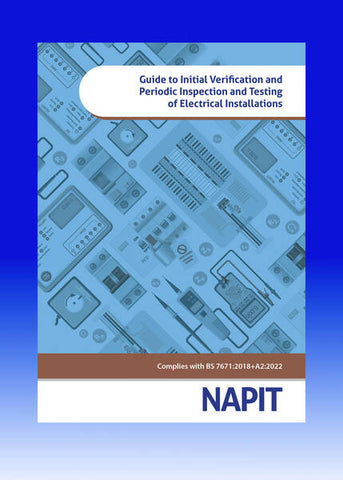
Guide to Initial and Periodic Inspection and Testing NAPIT's Guide to Initial and Periodic Inspection and Testing is an essential book for anyone qualified in inspection and testing; this new book explains all the different test equipment, what they are used for and how to perform all the required BS 7671 tests.
With our extensive experience and knowledge in this specific specialist and notoriously difficult area, we have combined the knowledge of our technical experts and produced a publication tailored to the needs of inspectors and testers.
Initial Validation and Periodic Inspection and Testing cover everything you need to carry out initial validation and periodic inspection, including the testing and production of the relevant certificate or report.
Comments will be approved before showing up.